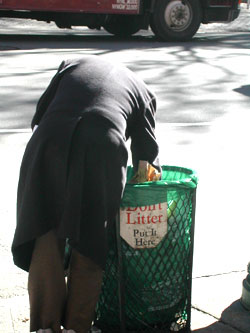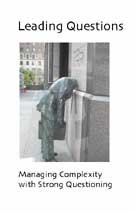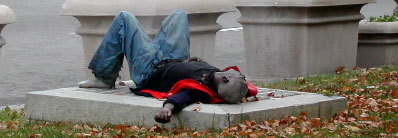
fno.org
|
|
| Vol 17|No 1|September 2007 | |
| Please feel free to e-mail this article to a friend, a principal, a parent, a colleague, a teacher librarian, a college professor, a poet, a magician, a vendor, an artist, a juggler, a student, a news reporter or to anyone else you think might enjoy it. | ||||||||||||||||||||||
Teaching Social Studies AuthenticallyBy Jamie McKenzieAbout author |
 |
|||||||||||||||||||||
|
In many countries, social studies teachers are under increased pressure to meet challenging objectives set by state or provincial curriculum standards. To meet these thinking, problem-solving and communicating standards, it pays to involve students in seeing how these skills are practiced outside of school in a variety of organizations contending with social issues. As much as possible, it makes sense to involve them in such work, either through internships, visits, interviews or simulations. Alternatively, much of this work can also be staged as historical simulations calling for decision-making set in the past.
This article will outline promising ways to manage learning opportunities of this kind. 1. The Rationale By employing such learning strategies within a real world context, students sharpen their abilities while gaining an appetite for the work at hand. Because they are rooted in the here and now, young ones find the challenges invigorating and intriguing. Caring about the tasks, they invest to a greater degree and emerge with a firmer and deeper grasp of the key concepts. If properly staged, historical simulations can also deliver passionate connections to provoke deep learning.Such is the promise of Fred Newmann's concept of "authentic teaching" that involves students in "authentic intellectual work" - often outside of school. Instead of busy work - repetitive tasks that require little thought and involve mere scooping, smushing, memorizing and regurgitating - Newmann's approach immerses students in challenges that demand imagination, resourcefulness, persistence and stamina.1 Even though some of these activities may be staged or simulated, they still pass the test of authenticity because they meet the following criteria:
What are the benefits for teachers? Teachers are promoting learning that increases student productivity, motivation and engagement. Stultifying routines are replaced by activities that spark curiosity while combating adolescent detachment or apathy. The teacher is rewarded with smiles, a forward lean and the satisfaction of witnessing learning infused with energy and enthusiasm. 2. The Strategy Social studies can be divided into two major categories – on the one hand, courses in the social sciences and on the other hand, courses in history. Social sciences (sociology, problems of democracy, government, civics, etc.) and geography are especially well suited to Newmann's approach while history classes will employ simulations to work its magic. In either case, students are involved researching important issues, problems and decisions with the goal of coming up with action plans or specific work products and documents that mirrors the real work done in agencies. Example One "If you were making recommendations to a local, state or federal government agency to address one of the following problems, what would be the five most important actions steps you would urge?"
The social science teacher provides a menu like the one above for students to explore as if they were working for an agency or organization charged with addressing (not just studying) those issues. The stress on action is a crucial aspect of what Newmann calls "authentic work products." Students must move beyond understanding issues to the development and presentation of plans intended to make good change. As much as possible, the teacher will organize workplace visits so that students can interview adults working in the agencies mentioned above and discover how they approach their work. Such visits set the scene for students to understand their roles as researchers and problem-solvers. In some cases, the agency may welcome student work products such as videos or Web pages that might serve a genuine purpose for that agency. In other cases, the agency may welcome student interns to work alongside the adults who are wrestling with difficult issues. A few centuries back adolescents were routinely engaged in real work as apprentices and employees, but modern society tends to keep young people disconnected from real work other than what are often called "Mac Jobs" - low skilled service jobs that do little to nurture their thinking and problem-solving skills. Newmann's approach restores a healthy connectedness to the adult workplace in ways that bring social issues to life while introducing the young to a richer view of career possibilities. Before splitting up the class into teams to explore issues and problems of choice, it is wise to take the entire class through a shared experience with a particular issue and agency. In this way the teacher may equip students for more independent work later on.
Example Two The teacher picks hunger as the introductory social issue to be addressed by the whole class. The class visits a local food bank and meets with the director and staff, then stays to help with food distribution. While interviewing the director, they are keen to identify the main challenges facing the food bank. As a result of their questions, they realize that the food bank has no Web presence and has difficulty raising funds. In addition, they recognize ways the local government has failed to support the food bank. It is clear they could do authentic work by creating a Web site for the food bank that would help create local support in the form of volunteers and contributions. They also see the possibility of lobbying the city council to provoke a more proactive support role on behalf of the food bank. The students divide into teams with the teacher's guidance and go to work. When they are done, the food bank can launch a spiffy Web site and look forward to increased contributions and volunteers. The students also ask to be placed on the agenda of the city council where they point out a series of actions the council might take to strengthen the effectiveness of the food bank. Thanks to their efforts, the work of the food bank is enhanced and several students sign up as volunteers to help out with the ongoing work of the organization. They have reason to feel proud of the real work they have done. There are dozens of agencies that teachers might select for this kind of introductory experience. A history teacher might use the visit outlined above to prepare students for an understanding of hunger during the time of the French Revolution, building a bridge between current events and historical events to make history more vivid and the human aspects more compelling. Once the students appreciate the current dynamics and urgencies of hunger, they are equipped to face hunger in a different time.
Example Three "Some historians suggest that Louis XVI was brought down in part by hunger and starvation. Imagine you and your team members are advising the King in the years from 1785-89. How should the King address the issues of hunger and starvation as well as taxation and wheat speculation?" Students consult sources such as The Project Gutenberg EBook of The French Revolution, by R. M. Johnston at http://www.gutenberg.org/files/19421/19421-8.txt.
As they read about taxation in France coupled at the time with speculation driving up the price of wheat, they begin to formulate changes in policies that might have saved the King from the guillotine. The king lacked foresight. Students have the advantage of 20-20 hindsight. Hunger seems especially real to them because they began with a visit to the food bank. If the King had made such visits, perhaps he would have been more alert to his danger and responsibility. To be historically accurate, students might create documents as if they were advisors writing to the King in that century. Alternatively, even though it might seem a bit modern, students could create a Web site, a blog or a podcast helping the populace to understand new policies meant to alleviate the hunger and curtail the speculation driving up the price of wheat. Desperate times call for drastic measures as well as great communication skills and technologies! They could apply modern technologies and 21st century skills to the trials and tribulations of 18th century France. 3. The Small Team Investigation Stage The first workplace investigation described earlier (the food bank) is a shared experience to ready small teams to conduct their own similar investigations of different issues selected from the matrix mentioned earlier. Teams of 4-5 students pass through the same steps but have more choice of what to study. While visiting and interviewing the director of the agency they have selected, the students focus on identifying the main challenges facing the organization. As a result of their questions, they recognize what work needs to be done and they follow their visit with the creation of authentic work products, many of which might be used by the agency. Example Four The class of 30 students divided into seven teams, each of which picks a different issue
Each team starts by identifying an agency that they might visit. The urban decay team, for example, meets with the city redevelopment office and finds that "tax reverted" properties are a big problem for the city.
The team researches to see what other states and cities have done about this problem. They find
They decide to launch a campaign to get their local state legislators to introduce similar legislation in the next session. They create a persuasive package complete with vivid photographs and video footage to present to the state senator. They include a comprehensive essay outlining the key issues and the rationale for the legislative package. When they are satisfied with the quality of their work, they meet with the senator and start the ball rolling. A year later they are invited to the ceremony when the new laws are signed by the governor of their state. Each of the other teams will follow a similar process, identifying an agency, determining work that needs to be done and setting to that work with a genuine sense of importance. 4. Other Examples of Authentic Intellectual Work A teacher could create a series of problems-based scenarios much like the ones described earlier that would be based on the teacher's research instead of requiring the time consuming student field research outlined earlier in this article. Simulations offer many efficiencies and may be created with enough veracity to capture the students' interest and accomplish the authenticity intended by Fred Newmann. These simulations might also serve middle school students well since they are a bit young to be producing work products that might actually be used by an agency. For these simulations to pass the test of authenticity, they must meet the criteria earlier in this article. As mentioned earlier, simulations and role-playing are promising strategies for history classes to engage students in thinking as actors in historical situations. Back in the 1970s some inquiry-based social studies texts used this approach to open every chapter. The example below is based on one of those dilemmas. Example Four "You are standing on the bank of the river watching someone swimming frantically toward your shore while a row boat seems to be chasing close behind with men shouting and waving rifles. You realize it is an escaped slave and the men are bounty hunters. The man will reach you in a matter of seconds and you must decide what you will do, knowing that assisting a runaway slave is a crime. What do you suppose you would do?" History is rich with opportunities to re-think, reconsider and review past decisions. A class could try individuals ranging from Sitting Bull or George Armstrong Custer to Andrew Carnegie or Sacco and Vanzetti, judging them for their actions. A class could imagine they have time traveled into a previous century to help the early English settlers of Virginia reconsider their strategies for handling the native people. Tom Snyder Productions produces excellent simulations that take advantage of new technologies to stage the decision-making. Decisions/Decisions is a series designed for students in Grades 5-10. Details are available at http://www.tomsnyder.com/. Decisions, Decisions 5.0 consists of the following titles:
Consequences When students are engaged in producing persuasive documents or media presentations, they are demonstrating the capacity to apply what many consider to be 21st century skills to the solution of thorny issues and problems. They are acquiring abilities that will serve them well as adults, and they are doing so in a way that is highly motivating. In some cases, their work will make the world a better place for us all. Resources 1. Five Standards of Authentic Instruction - Fred M. Newmann and Gary G.Wehlage http://www.learner.org/channel/workshops/socialstudies/ Social Studies School Service at http://www.socialstudies.com/ is an excellent source of simulations. |
||||||||||||||||||||||
|
Copyright Policy: Materials published in From Now On may be duplicated in hard copy format if unchanged in format and content for educational, nonprofit school district and university use only and may also be sent from person to person by e-mail. This copyright statement must be included. All other uses, transmissions and duplications are prohibited unless permission is granted expressly. Showing these pages remotely through frames is not permitted. |
||||||||||||||||||||||

Info

